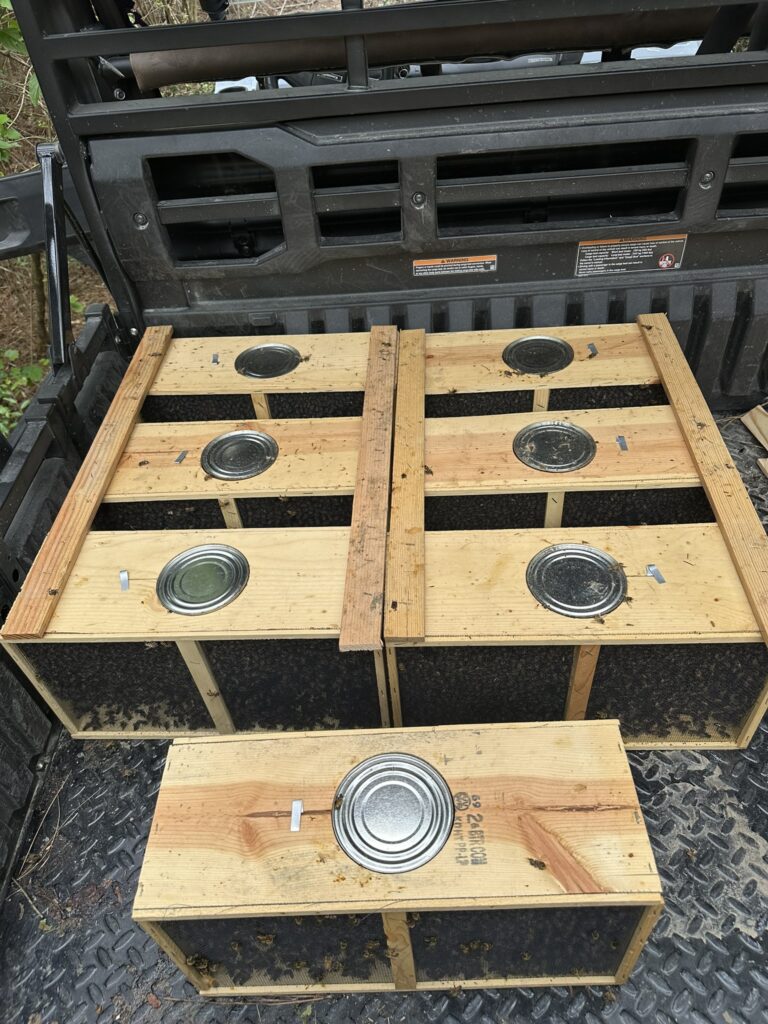When starting into beekeeping, one of the biggest questions is where do you get bees? There are a few ways that bees are supplied / acquired and there are lots of sources. I will try to go through my process to select my bees.
First, we can look at the ways that bees are supplied. Most suppliers will provide “package,” “nuc,” and “hive.”
The package is generally 2-3 pounds of bees with a queen. The bees are somewhat randomly removed from an established hive, and the queen is a queen which has been bred for sale. As such, the bees in the package is not related and will have to become acclimated to the queen. This package will be “dumped” into a hive with frames (generally without comb already present), and the bees will build comb and develop the hive. Packages are the least expensive way to purchase bees (other than getting them for free, to be discussed below), but require the most work to get them started. That being said, using a package provides the best control over what is in a hive since they will produce all of the comb, so there is not a risk that someone else used chemicals or other contaminants in the hives which the comb was produced. In addition, if using a hive type other than langstroth, packages are likely the only option. Below is a picture of 7 packages ready to be installed in an apiary.

The next form which bees can be purchased is a “nuc” or nucleus colony. This is available, generally, as a 5 frame langstroth box with 4 frames of comb and a feeder frame. The comb is pulled from established hives and will include brood and honey. The bees and queen, however will typically be similar to the package in that they did not come from the colony which produced the comb and they are not related. Using a nuc allows the colony to be established quicker, but they only go into a langstroth hive (or have to be modified to go into other styles).
The most complete form that bees can be purchased is an established hive (typically 10 frame). This is a complete hive, and unlike the others discussed above, this colony is produced by the queen which is supplied. This is also the most expensive form to purchase.
Alternatively, there are a couple free ways to get bees. First, swarm trap boxes can be placed in areas which bees are thought to be present. For various reasons, bees will decide to leave the hive and find a new home. In this event, if we can supply them an appropriate home (swarm box) at the correct location, they will move into our box, which we can then move to our apiary. These swarms will also find their own home (sometimes in our houses, water meter boxes, or other locations), and these can be collected and moved into hive boxes.
Regardless of the form which the bees will be supplied, what I believe is a more important question is the genetics and source of the bees. Bees which I purchase will be located in South Texas, so I want bees whose genetics are from an area as close as possible. This is because the bees must modify their activities based on the season. Many of the bees which are kept by beekeepers in the US have origins in Italy, which has a warm climate throughout the year. As such, these bees can be good produces, but from a long-term genetic standpoint, they produce without concern of significant winters. We are lucky in South Texas that our climate is not significantly different, but it is still not quite the same. So, “local” bees will tend to have behaviors based on local climate, not other parts of the country or world. In addition, my belief is that we should be keeping bees in a treatment free manner wherever possible. Bees which have been kept with treatment may not have the genetic traits which are naturally resistant to some of the pests which they will experience since they have not needed to have this resistance with treatments. So, if we want to have bees with the best resistance, we want bees that have been bred with this in mind. Combining these, I personally look for local bees that have as long a history of treatment free breeding as possible.
With all of this in mind, personally, my bees come from Beeweaver, and since I keep Layens hives, I purchase packages. In a pinch, I will purchase from other suppliers, and I try to support local. That being said, in 2023, I purchased from another supplier. One purchase included 2 packages which had a high mortality for the package by the time that they made it to the apiary, and the entire shipment which the supplier received (which included packages to replace the lost packages) died between arrival at their site and pickup.
Beeweaver: https://beeweaver.com/